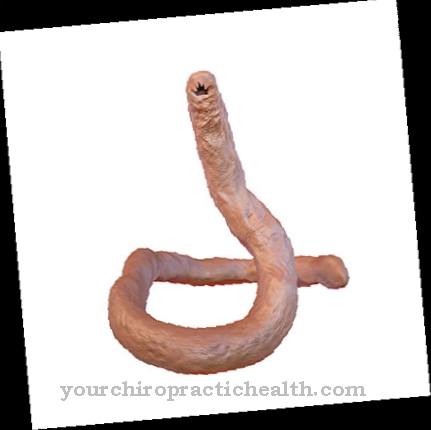The Segawa syndrome is a very rare hereditary disease of the nervous system, which shows symptoms similar to Parkinson's disease. The disease belongs to the large group of dystonias, which are characterized by stiffening of the muscles. If the disease is correctly diagnosed, treatment is very simple and effective.
What is Segawa Syndrome?

© SciePro - stock.adobe.com
The Segawa syndrome as an extremely rare hereditary disease of the nervous system belongs to the large heterogeneous group of dystonias. Dystonia is characterized by the stiffening of the muscles, which is caused by a disruption in the tone of the muscles. This involves involuntary contractions of the skeletal muscles.
Cramps and abnormal postures occur, which are sustained for a long time. However, the individual dystonias have different causes. Segawa syndrome is idiopathic dystonia, i.e. muscle stiffness without an externally recognizable cause.
It is now known that the disease is hereditary. The clinical picture of Segawa syndrome was first described by the Japanese neurologist Masaya Segawa in 1970. He also realized that it was a disease in its own right.
Since the syndrome has many similarities with Parkinson's disease, it is still often confused with this disease and is sometimes referred to as an atypical Parkinson's disease. However, Segawa syndrome has nothing to do with Parkinson's disease. In both diseases there are disorders in the dopamine metabolism.
However, their causes are completely different. The disease is different in each patient and is therefore often not diagnosed immediately. Therefore their frequency is not exactly known. It is believed that one in every million people has Segawa syndrome.
causes
A gene mutation on the long arm of chromosome 14 is held responsible for the Segawa syndrome. It is the GCH1 gene, which codes for the enzyme GTP cyclohydrolase. GTP cyclohydrolase is the rate-limiting enzyme in the synthesis of tetrahydrobiopterin (BH4).
Tetrahydrobiopterin, in turn, is responsible for the formation of dopamine. A mutation of the GCH1 gene can therefore lead to a deficiency of BH4 and thus of dopamine. The mutation is inherited in an autosomal dominant manner. However, the penetrance of the genetic defect fluctuates. Symptoms are rarely seen in some patients, while others are severe.
Sometimes an autosomal recessive inheritance is suspected, but it is said to be due to a different gene. This gene is located on chromosome 11 and is responsible for coding tyrosine hydroxylase. As a result of the described genetic defects, there is a lack of dopamine. Because of the delayed synthesis, the neurotransmitter cannot be re-synthesized quickly enough after it has been consumed.
The stores for dopamine are empty and are no longer available for muscle reactions after a certain period of physical activity. Muscle stiffening occurs.
Symptoms, ailments & signs
Segawa syndrome initially manifests itself as a gait disorder that worsens over the course of the day. An inward position of the feet develops. This position can become so solid that further movements become impossible.
It can happen that affected children go to school alone early in the morning and may even have to be picked up in a wheelchair in the afternoon because they can no longer walk. In the course of physical activity, dopamine stores are used up in this disease and not replenished quickly enough.
In addition to the inward rotation of the feet, Parkinson's-like symptoms such as general muscle stiffening, sedentary lifestyle, tremors or the loss of postural reflexes can occur. It was also found that more female patients than male patients are affected by Segawa syndrome. The first symptoms usually appear in the first decade of life between the ages of four and eight. In a few cases, however, symptoms do not start until early adulthood.
Diagnosis & course of disease
Segawa syndrome is actually very easy to diagnose. The diagnosis can be made based on the typical symptoms. A typical feature of this disease is that the inability to move always sets in during the day after physical activity. Symptoms gradually disappear after periods of rest or after sleeping at night.
The reason for this is to be found in the slow production of dopamine in the body. After the correct diagnosis, Segawa syndrome is also the only dystonia that can be treated causally until the symptoms are free. However, because this disease is so rare, it is often not recognized by the examining doctor. There are misdiagnoses, which often lead to further suffering for some patients.
Complications
Segawa syndrome can cause serious complications. The typical gait disorders occasionally lead to accidents and falls, which in turn lead to fractures and injuries. In general, the condition causes severe physical discomfort. Symptoms such as tremors and stiff muscles represent a significant psychological burden for those affected in the long run.
The consequences are mental illnesses such as depression, anxiety disorders or inferiority complexes. Since mostly children are affected, the parents often suffer too. The need for care for one's own children is associated with stress and fears, which in the long term can also develop into serious mental illnesses. Therapy for Segawa syndrome can also cause adverse events.
The typically prescribed preparation L-DOPA can trigger serious side effects. Typical are disorders in movement, nausea and vomiting, urine discoloration and abdominal pain. Often there are also psychological disorders such as restlessness, anxiety disorders and moods.
Sleep disorders are just as possible as indigestion, muscle stiffness, increased sweating and uncontrolled movements. In individual cases, side effects such as gastric bleeding, skin rashes and liver inflammation with biliary congestion occur. Allergic reactions to the administered preparations cannot be ruled out either.
When should you go to the doctor?
Segawa syndrome must always be examined and treated by a doctor. There can be no self-healing, since this disease is a hereditary disease, which therefore cannot be treated causally but only symptomatically. An early diagnosis and treatment of the syndrome have a positive effect on the further course.
A doctor should be consulted in the case of Segawa syndrome if the person concerned suffers from a severe gait disorder, whereby this gait disorder usually becomes significantly worse if left untreated. Often those affected are then dependent on a walking aid or even a wheelchair and can no longer cope with everyday life on their own. The trembling of the muscles also suggests Segawa syndrome.
If these symptoms occur, a doctor must be consulted in any case. The diagnosis of Segawa syndrome is made by a general practitioner or an orthopedic surgeon, although further treatment must be carried out by a specialist. A complete cure cannot be obtained.
Treatment & Therapy
Once properly diagnosed, Segawa syndrome can be treated very well. Although the disease is not curable due to its hereditary nature, there are no symptoms with lifelong drug treatment. All that is needed is to compensate for the lack of dopamine production by substituting L-DOPA (levodopa).
L-DOPA is a prodrug that is converted into dopamine in the brain. Dopamine itself cannot be administered because it cannot cross the blood-brain barrier. L-DOPA can, however. By splitting off carbon dioxide, it then forms dopamine in the brain, which maintains the ability of the muscles to move.
prevention
Prevention against Segawa syndrome is not possible. It is hereditary and familial accumulation has not been observed. After the first appearance of the typical symptoms, only a life-long substitution with levodopa can ensure freedom from symptoms.
Aftercare
In the case of Segawa syndrome, those affected usually have only a few and only very limited measures available for direct follow-up care. For this reason, the person concerned should ideally see a doctor early to prevent other complications and complaints from occurring. Segawa syndrome cannot heal on its own.
Since Segawa syndrome is a hereditary condition, it usually cannot be completely cured. For this reason, the person concerned should have a genetic examination and counseling carried out if they want to have children in order to prevent the disease from recurring in their descendants. Some of the symptoms can be relieved by taking various medications.
The person affected should ensure that the dosage is correct and that the medication is taken regularly in order to counteract the symptoms. A doctor should also be consulted first if there are severe side effects or if anything is unclear. The further course of this syndrome is highly dependent on the exact severity of the disease, so that no general prediction can be made. Segawa syndrome may limit the patient's life expectancy.
You can do that yourself
Segawa syndrome leads to a disturbed gait in everyday life and sometimes even to falls. It is therefore very important for those affected to take the prescribed medication correctly. The symptoms can only be successfully avoided in the long term with the appropriate medication.
The typical movement problems typically arise after physical activity and decrease after a break or a good night's sleep. There is therefore a risk that those affected will recognize the problem too late. A medical diagnosis helps analyze and treat the rare disease. In contrast to other dystonias, it can be treated successfully so that those affected no longer have any symptoms. To minimize complications, patients should be careful when they notice the first signs of gait disorder. In this way, accidents and injuries can be avoided in good time.
The drugs help against physical discomfort. Especially when the typical tremor occurs in combination with a stiffening of the muscles, the psyche also suffers from the disease.This can lead to feelings of anxiety, complexes and depression. If children are affected, parents should obtain comprehensive information so that they can help their offspring. This reduces the stress level and there are fewer psychological complications.



.jpg)









.jpg)

.jpg)
.jpg)











.jpg)